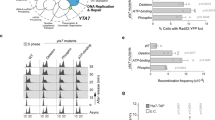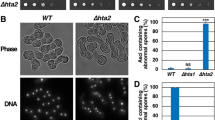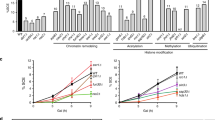Abstract
Histone variant H2A.Z has a conserved role in genome stability, although it remains unclear how this is mediated. Here we demonstrate that the fission yeast Swr1 ATPase inserts H2A.Z (Pht1) into chromatin and Kat5 acetyltransferase (Mst1) acetylates it. Deletion or an unacetylatable mutation of Pht1 leads to genome instability, primarily caused by chromosome entanglement and breakage at anaphase. This leads to the loss of telomere-proximal markers, though telomere protection and repeat length are unaffected by the absence of Pht1. Strikingly, the chromosome entanglement in pht1Δ anaphase cells can be rescued by forcing chromosome condensation before anaphase onset. We show that the condensin complex, required for the maintenance of anaphase chromosome condensation, prematurely dissociates from chromatin in the absence of Pht1. This and other findings suggest an important role for H2A.Z in the architecture of anaphase chromosomes.
This is a preview of subscription content, access via your institution
Access options
Subscribe to this journal
Receive 12 print issues and online access
$189.00 per year
only $15.75 per issue
Buy this article
- Purchase on Springer Link
- Instant access to full article PDF
Prices may be subject to local taxes which are calculated during checkout






Similar content being viewed by others
Accession codes
References
Henikoff, S., Furuyama, T. & Ahmad, K. Histone variants, nucleosome assembly and epigenetic inheritance. Trends Genet. 20, 320–326 (2005).
Latham, J.A. & Dent, S.Y.R. Cross-regulation of histone modifications. Nat. Struct. Mol. Biol. 14, 1017–1024 (2007).
Millar, C.B. & Grunstein, M. Genome-wide patterns of histone modifications in yeast. Nat. Rev. Mol. Cell Biol. 7, 657–666 (2006).
Faast, R. et al. Histone variant H2A.Z is required for early mammalian development. Curr. Biol. 11, 1183–1187 (2001).
Rangasamy, D., Greaves, I. & Tremethick, D.J. RNA interference demonstrates a novel role for H2A.Z in chromosome segregation. Nat. Struct. Mol. Biol. 11, 650–655 (2004).
Leach, T.J. et al. Histone H2A.Z is widely but non-randomly distributed in chromosomes of Drosophila melanogaster. J. Biol. Chem. 275, 23267–23272 (2000).
Rangasamy, D., Berven, L., Ridgway, P. & Tremethick, D.J. Pericentric heterochromatin becomes enriched with H2A.Z during early mammalian development. EMBO J. 22, 1599–1607 (2003).
Greaves, I.K., Rangasamy, D., Devoy, M., Marshall Graves, J.A. & Tremethick, D.J. The X and Y chromosomes assemble into H2A.Z, containing facultative heterochromatin, following meiosis. Mol. Cell. Biol. 26, 5394–5405 (2006).
Keogh, M.-C. The Saccharomyces cerevisiae histone H2A variant Htz1 is acetylated by NuA4. Genes Dev. 20, 660–665 (2006).
Millar, C.B., Xu, F., Zhang, K. & Grunstein, M. Acetylation of H2AZ lysine 14 is associated with genome-wide gene activity in yeast. Genes Dev. 20, 711–722 (2006).
Babiarz, J.E., Halley, J.E. & Rine, J. Telomeric heterochromatin boundaries require NuA4-dependent acetylation of histone variant H2A.Z in Saccharomyces cerevisiae. Genes Dev. 20, 700–710 (2006).
Ren, Q. & Gorovsky, M.A. Histone H2A.Z acetylation modulates an essential charge patch. Mol. Cell 7, 1329–1335 (2001).
Bruce, K. et al. The replacement histone H2A.Z in a hyperacetylated form is a feature of active genes in the chicken. Nucleic Acids Res. 33, 5633–5639 (2005).
Bonenfant, D., Coulot, M., Towbin, H., Schindler, P. & van Oostrum, J. Characterization of histone H2A and H2B variants and their post-translational modifications by mass spectrometry. Mol. Cell. Proteomics 5, 541–552 (2006).
Krogan, N.J. et al. Regulation of chromosome stability by the histone H2A variant Htz1, the Swr1 chromatin remodeling complex and the histone acetyltransferase NuA4. Proc. Natl. Acad. Sci. USA 101, 13513–13518 (2004).
Gómez, E.B., Nugent, R.L., Laria, S. & Forsburg, S.L. S. pombe histone acetyltransferase Mst1 (KAT5) is an essential protein required for damage response and chromosome segregation. Genetics 179, 757–771 (2008).
Krogan, N.J. et al. A Snf2-Family ATPase complex required for recruitment of the histone H2A variant Htz1. Mol. Cell 12, 1565–1576 (2003).
Kobor, M.S. et al. A protein complex containing the conserved Swi2/Snf2-related ATPase Swr1p deposits histone variant H2A.Z into euchromatin. PLoS Biol. 2, e131 (2004).
Mizuguchi, G. et al. ATP-driven exchange of histone H2AZ variant catalyzed by SWR1 chromatin remodeling complex. Science 303, 343–348 (2004).
Roguev, A. et al. Conservation and rewiring of functional modules revealed by an epistasis map (E-MAP) in fission yeast. Science 322, 405–410 (2008).
Roguev, A., Wiren, M., Weissman, J.S. & Krogan, N.J. High-throughput genetic interaction mapping in the fission yeast Schizosaccharomyces pombe. Nat. Methods 4, 861–866 (2007).
Schuldiner, M. et al. Exploration of the function and organization of the yeast early secretory pathway through an epistatic miniarray profile. Cell 123, 507–519 (2005).
Collins, S.R. et al. Functional dissection of protein complexes involved in yeast chromosome biology using a genetic interaction map. Nature 446, 806–810 (2007).
Collins, S.R., Schuldiner, M., Krogan, N.J. & Weissman, J.S. A strategy for extracting and analyzing large-scale quantitative epistatic interaction data. Genome Biol. 7, R63 (2006).
Carr, A.M. et al. Analysis of a histone H2A variant from fission yeast: evidence for a role in chromosome stability. Mol. Gen. Genet. 245, 628–635 (1994).
Ahmed, S., Dul, B., Qiu, X. & Walworth, N.C. Msc1 acts through histone H2A.Z to promote chromosome stability in Schizosaccharomyces pombe. Genetics 177, 1487–1497 (2008).
Ekwall, K. Epigenetic control of centromere behaviour. Annu. Rev. Genet. 41, 63–81 (2007).
Gregan, J. et al. The kinetochore proteins Pcs1 and Mde4 and heterochromatin are required to prevent merotelic orientation. Curr. Biol. 17, 1190–1200 (2007).
Cooper, J.P., Nimmo, E.R., Allshire, R.C. & Cech, T.R. Regulation of telomere length and function by a Myb-domain protein in fission yeast. Nature 385, 744–747 (1997).
Ding, D.-Q., Yamamoto, A., Haraguchi, T. & Hiraoka, Y. Dynamics of homologous chromosome pairing during meiotic prophase in fission yeast. Dev. Cell 6, 329–341 (2004).
Vanoosthuyse, V., Prykhozhij, S. & Hardwick, K.G. Shugoshin 2 regulates localization of the chromosomal passenger proteins in fission yeast mitosis. Mol. Biol. Cell 18, 1657–1669 (2007).
Kawashima, S.A. et al. Shugoshin enables tension-generating attachment of kinetochores by loading Aurora to centromeres. Genes Dev. 21, 420–435 (2007).
Nakazawa, N. et al. Dissection of the essential steps for condensin accumulation at kinetochores and rDNAs during fission yeast mitosis. J. Cell Biol. 180, 1115–1131 (2008).
Saka, Y. et al. Fission yeast cut3 and cut14, members of a ubiquitous protein family, are required for chromosome condensation and segregation in mitosis. EMBO J. 13, 4938–4952 (1994).
Sutani, T. et al. Fission yeast condensin complex: essential roles of non-SMC subunits for condensation and Cdc2 phosphorylation of Cut3/SMC4. Genes Dev. 13, 2271–2283 (1999).
Hagstrom, K.A., Holmes, V.F., Cozzarelli, N.R. & Meyer, B.J. C. elegans condensin promotes mitotic chromosome architecture, centromere organization, and sister chromatid segregation during mitosis and meiosis. Genes Dev. 16, 729–742 (2002).
Hiraoka, Y., Toda, T. & Yanagida, M. The NDA3 gene of fission yeast encodes β-tubulin: a cold-sensitive nda3 mutation reversibly blocks spindle formation and chromosome movement in mitosis. Cell 39, 349–358 (1984).
Chen, E.S. et al. Cell cycle control of centromeric repeat transcription and heterochromatin assembly. Nature 451, 734–737 (2008).
Sipiczki, M. Where does fission yeast sit on the tree of life? Genome Biol. 1, 1011 (2000).
O'Brien, S.J. et al. The promise of comparative genomics in mammals. Science 286, 458–462 (1999).
Takahata, N. & Satta, Y. Evolution of the primate lineage leading to modern humans: phylogenetic and demographic inferences from DNA sequences. Proc. Natl. Acad. Sci. USA 94, 4811–4815 (1997).
Shevchenko, A. et al. Chromatin central: towards the comparative proteome by accurate mapping of the yeast proteomic environment. Genome Biol. 9, R167 (2008).
Ahmed, S., Palermo, C., Wan, S. & Walworth, N.C. A novel protein with similarities to Rb binding protein 2 compensates for loss of chk1 function and affects histone modification in fission yeast. Mol. Cell. Biol. 24, 3660–3669 (2004).
Choi, K. et al. Arabidopsis homologs of components of the SWR1 complex regulate flowering and plant development. Development 134, 1931–1941 (2007).
Ruhl, D.D. et al. Purification of a human SCRAP complex that remodels chromatin by incorporating the histone variant H2A.Z into nucleosomes. Biochemistry 45, 5671–5677 (2006).
Kusch, T. et al. Acetylation by Tip60 is required for selective histone variant exchange at DNA lesions. Science 306, 2084–2087 (2004).
Updike, D.L. & Mango, S.E. Temporal regulation of foregut development by HTZ-1/H2A.Z and PHA-4/FoxA. PLoS Genet. 2, e161 (2006).
Vagnarelli, P. et al. Condensin and Repo-Man-PP1 co-operate in the regulation of chromosome architecture during mitosis. Nat. Cell Biol. 8, 1133–1142 (2006).
Fiedler, D. et al. Functional organization of the S. cerevisiae phosphorylation network. Cell 136, 952–963 (2009).
Nabetani, A., Koujin, T., Tsutsumi, C., Haraguchi, T. & Hiraoka, Y. A conserved protein, Nuf2, is implicated in connecting the centromere to the spindle during chromosome segregation: a link between the kinetochore function and the spindle checkpoint. Chromosoma 110, 322–334 (2001).
Gulli, M.P. et al. gar2 is a nucleolar protein from Schizosaccharomyces pombe required for 18S rRNA and 40S ribosomal subunit accumulation. Nucleic Acids Res. 23, 1912–1918 (1995).
Hagstrom, K.A. & Meyer, B.J. Condensin and cohesin: more than chromosome compactor and glue. Nat. Rev. Genet. 4, 520–534 (2003).
Hirano, T. Condensins: Organizing and segregating the genome. Curr. Biol. 15, R265–R275 (2005).
Dunaway, S. & Walworth, N.C. Assaying the DNA damage checkpoint in fission yeast. Methods 33, 260–263 (2004).
Lyne, R. et al. Whole-genome microarrays of fission yeast: characteristics, accuracy, reproducibility, and processing of array data. BMC Genomics 4, 27 (2003).
Niwa, O., Matsumoto, T. & Yanagida, M. Construction of a mini-chromosome by deletion and its mitotic and meiotic behaviour in fission yeast. Mol. Genet. Genomics 203, 397–405 (1986).
Krogan, N.J. et al. RNA polymerase II elongation factors of Saccharomyces cerevisiae: a targeted proteomics approach. Mol. Cell. Biol. 22, 6979–6992 (2002).
Acknowledgements
We thank R. Allshire (Univ. of Edinburgh), M. Bühler (Friedrich Miescher Institute for Biomedical Research), J. Cooper (Cancer Research UK), D. Finley (Harvard Medical School), S. Forsburg (Univ. of Southern California, Los Angeles), K. Gull (Univ. of Oxford), C. Hoffmann (Boston College), J. Kanoh (Kyoto Univ.), R. Maraia (NIH), D. Moazed (Harvard Medical School), T. Nakamura (Univ. of Illinois at Chicago), F. Neumann (Rockefeller Univ.), P. Nurse (Rockefeller Univ.), M. O'Connell (Mount Sinai School of Medicine), J. Partridge (St. Judes Children's Research Hospital), M. Yanagida (Kyoto Univ.) and the Yeast Genome Resource Center (Osaka City Univ.) for the generous supply of antibodies and yeast strains (detailed in Supplementary Tables 3 and 4). We also thank G. Zhong, S. Chandran, T. Punna and M. Shales for technical support. Finally, we are grateful to G. Ingram for expertise with the Telomere Repeat Length assay. Work in the J.B. lab is funded by Cancer Research UK, T.K. lab by a start-up grant from the Ontario Cancer Institute, K.G.H. lab by a program grant from the Wellcome Trust and M.-C.K. lab by an NCI Cancer Center Support grant to Albert Einstein College of Medicine (2P30CA013330) and the Speaker's Fund for Biomedical Research: Toward the Science of Patient Care, awarded by the City of New York.
Author information
Authors and Affiliations
Contributions
H.-S.K. was responsible for the data in Figure 1 (with A.T. contributing Fig. 1c), Figure 2 (with MS help from J.F., T.K., A.E. and J.F.G.), Figures 5c and 5d and Supplementary Figures 1 and 3. V.V. (with help from K.G.H.) was responsible for the data in Figures 4 and 5a–c and Supplementary Figures 2, 3a and 4. S.W. and J.B. performed and analyzed the microarrays in Figures 3a and 3b; A.R. and N.J.K. performed and analyzed the genetic screens in Figures 3c–f. L.R.C. and C.S.B. created the antibodies to Pht1 used in Figure 1. H.-S.K., V.V. and M.-C.K. planned experiments, analyzed the data and wrote the manuscript.
Corresponding authors
Supplementary information
Supplementary Text and Figures
Supplementary Figures 1–4 and Supplementary Tables 1–5 (PDF 6161 kb)
Rights and permissions
About this article
Cite this article
Kim, HS., Vanoosthuyse, V., Fillingham, J. et al. An acetylated form of histone H2A.Z regulates chromosome architecture in Schizosaccharomyces pombe. Nat Struct Mol Biol 16, 1286–1293 (2009). https://doi.org/10.1038/nsmb.1688
Received:
Accepted:
Published:
Issue Date:
DOI: https://doi.org/10.1038/nsmb.1688
This article is cited by
-
A three layered histone epigenetics in breast cancer metastasis
Cell & Bioscience (2020)
-
The NuA4 acetyltransferase and histone H4 acetylation promote replication recovery after topoisomerase I-poisoning
Epigenetics & Chromatin (2019)
-
The bromodomain-containing protein Ibd1 links multiple chromatin-related protein complexes to highly expressed genes in Tetrahymena thermophila
Epigenetics & Chromatin (2018)
-
The conserved histone variant H2A.Z illuminates meiotic recombination initiation
Current Genetics (2018)
-
Histone H4 acetylation required for chromatin decompaction during DNA replication
Scientific Reports (2015)



